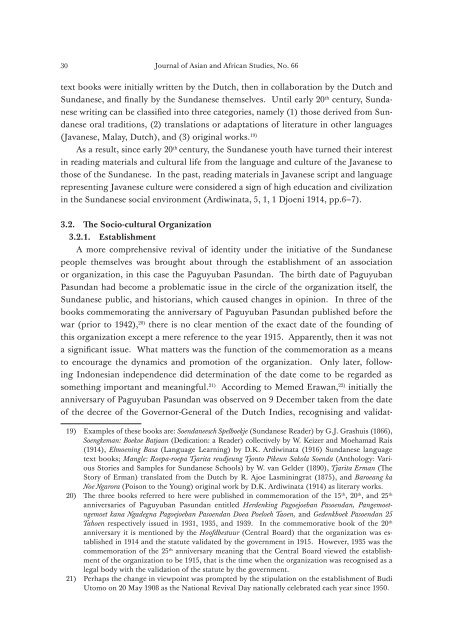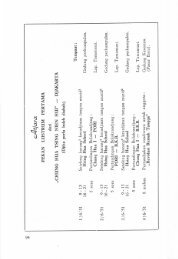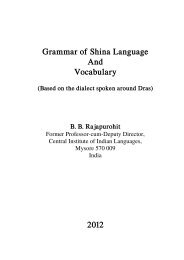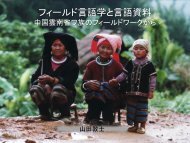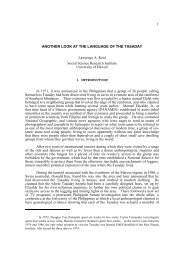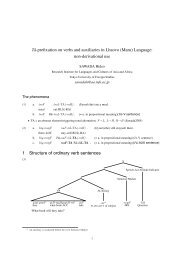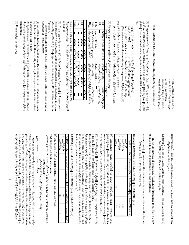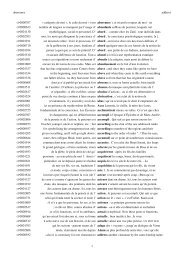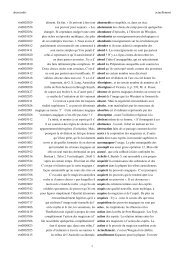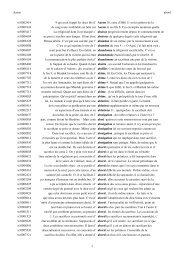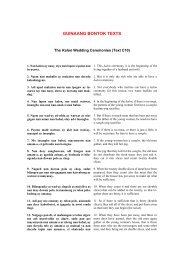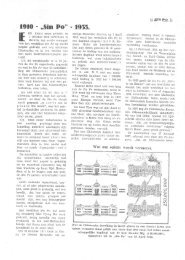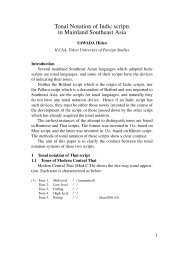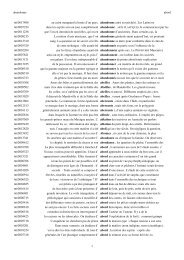ç® æ¬¡ - æ±äº¬å¤å½èªå¤§å¦ã¢ã¸ã¢ã»ã¢ããªã«è¨èªæåç 究æ
ç® æ¬¡ - æ±äº¬å¤å½èªå¤§å¦ã¢ã¸ã¢ã»ã¢ããªã«è¨èªæåç 究æ
ç® æ¬¡ - æ±äº¬å¤å½èªå¤§å¦ã¢ã¸ã¢ã»ã¢ããªã«è¨èªæåç 究æ
Create successful ePaper yourself
Turn your PDF publications into a flip-book with our unique Google optimized e-Paper software.
Journal of Asian and African Studies, No. <br />
text books were initially written by the Dutch, then in collaboration by the Dutch and<br />
Sundanese, and finally by the Sundanese themselves. Until early th century, Sundanese<br />
writing can be classified into three categories, namely () those derived from Sundanese<br />
oral traditions, () translations or adaptations of literature in other languages<br />
(Javanese, Malay, Dutch), and () original works. )<br />
As a result, since early th century, the Sundanese youth have turned their interest<br />
in reading materials and cultural life from the language and culture of the Javanese to<br />
those of the Sundanese. In the past, reading materials in Javanese script and language<br />
representing Javanese culture were considered a sign of high education and civilization<br />
in the Sundanese social environment (Ardiwinata, , , Djoeni , pp.–).<br />
.. e Socio-cultural Organization<br />
... Establishment<br />
A more comprehensive revival of identity under the initiative of the Sundanese<br />
people themselves was brought about through the establishment of an association<br />
or organization, in this case the Paguyuban Pasundan. e birth date of Paguyuban<br />
Pasundan had become a problematic issue in the circle of the organization itself, the<br />
Sundanese public, and historians, which caused changes in opinion. In three of the<br />
books commemorating the anniversary of Paguyuban Pasundan published before the<br />
war (prior to ), ) there is no clear mention of the exact date of the founding of<br />
this organization except a mere reference to the year . Apparently, then it was not<br />
a significant issue. What matters was the function of the commemoration as a means<br />
to encourage the dynamics and promotion of the organization. Only later, following<br />
Indonesian independence did determination of the date come to be regarded as<br />
something important and meaningful. ) According to Memed Erawan, ) initially the<br />
anniversary of Paguyuban Pasundan was observed on December taken from the date<br />
of the decree of the Governor-General of the Dutch Indies, recognising and validat-<br />
) Examples of these books are: Soendaneesch Spelboekje (Sundanese Reader) by G.J. Grashuis (),<br />
Soengkeman: Boekoe Batjaan (Dedication: a Reader) collectively by W. Keizer and Moehamad Rais<br />
(), Elmoening Basa (Language Learning) by D.K. Ardiwinata () Sundanese language<br />
text books; Mangle: Roepa-roepa Tjarita reudjeung Tjonto Pikeun Sakola Soenda (Anthology: Various<br />
Stories and Samples for Sundanese Schools) by W. van Gelder (), Tjarita Erman (e<br />
Story of Erman) translated from the Dutch by R. Ajoe Lasminingrat (), and Baroeang ka<br />
Noe Ngarora (Poison to the Young) original work by D.K. Ardiwinata () as literary works.<br />
) e three books referred to here were published in commemoration of the th , th , and th<br />
anniversaries of Paguyuban Pasundan entitled Herdenking Pagoejoeban Pasoendan, Pangemoetngemoet<br />
kana Ngadegna Pagoejoeban Pasoendan Doea Poeloeh Taoen, and Gedenkboek Pasoendan <br />
Tahoen respectively issued in , , and . In the commemorative book of the th<br />
anniversary it is mentioned by the Hoofdbestuur (Central Board) that the organization was established<br />
in and the statute validated by the government in . However, was the<br />
commemoration of the th anniversary meaning that the Central Board viewed the establishment<br />
of the organization to be , that is the time when the organization was recognised as a<br />
legal body with the validation of the statute by the government.<br />
) Perhaps the change in viewpoint was prompted by the stipulation on the establishment of Budi<br />
Utomo on May as the National Revival Day nationally celebrated each year since .


